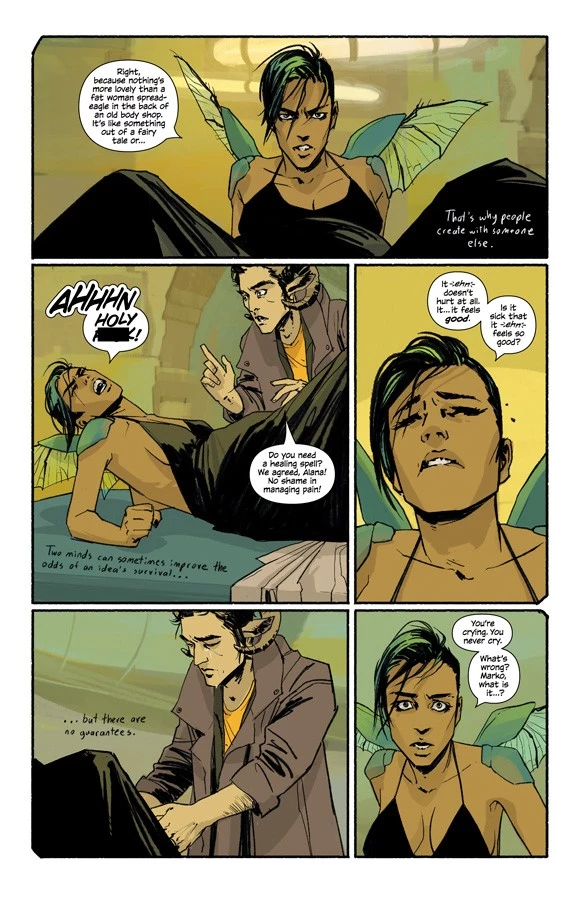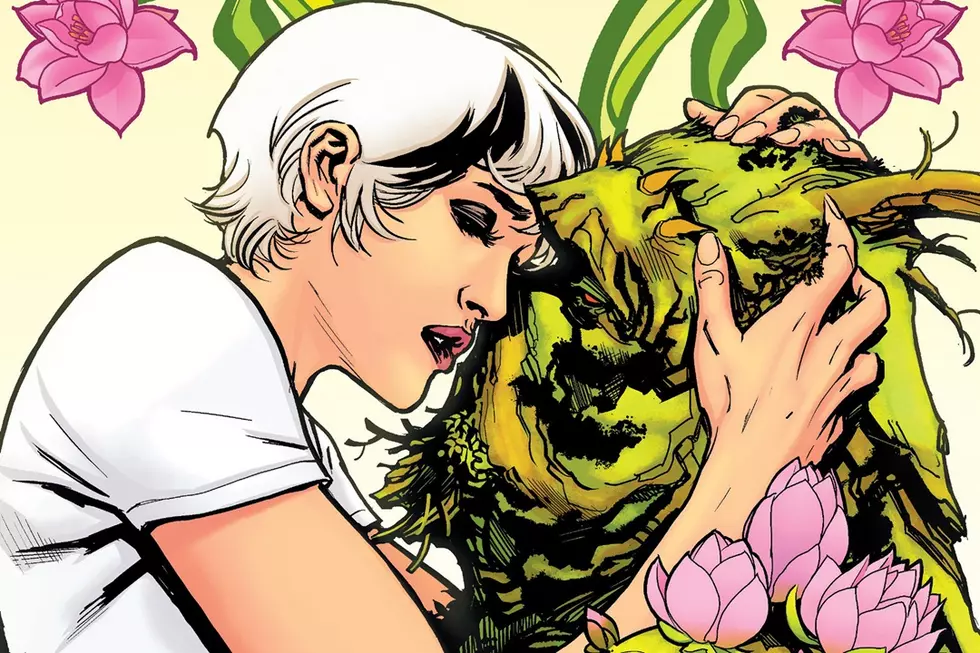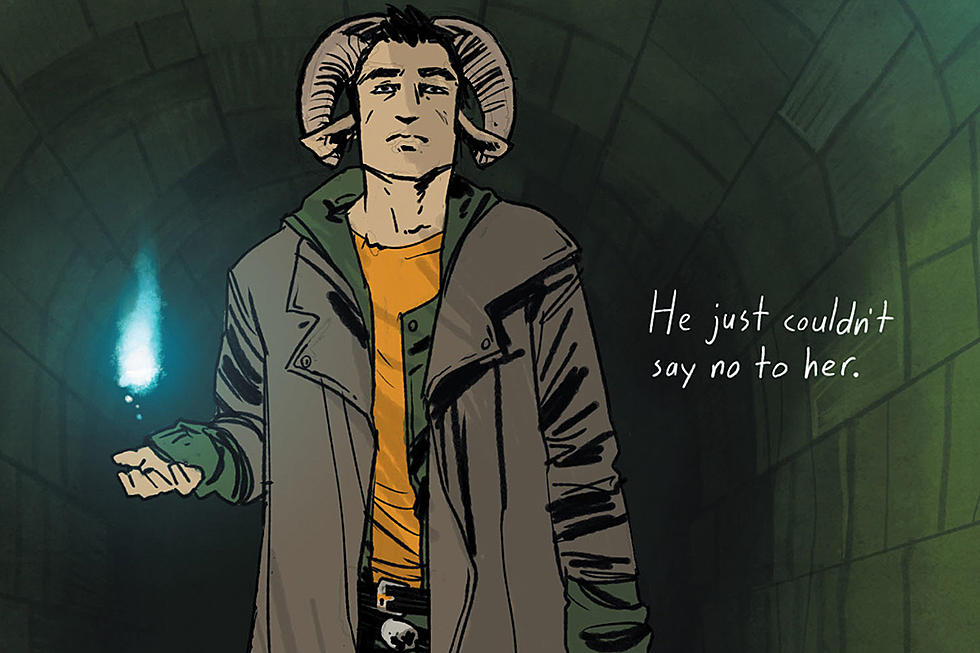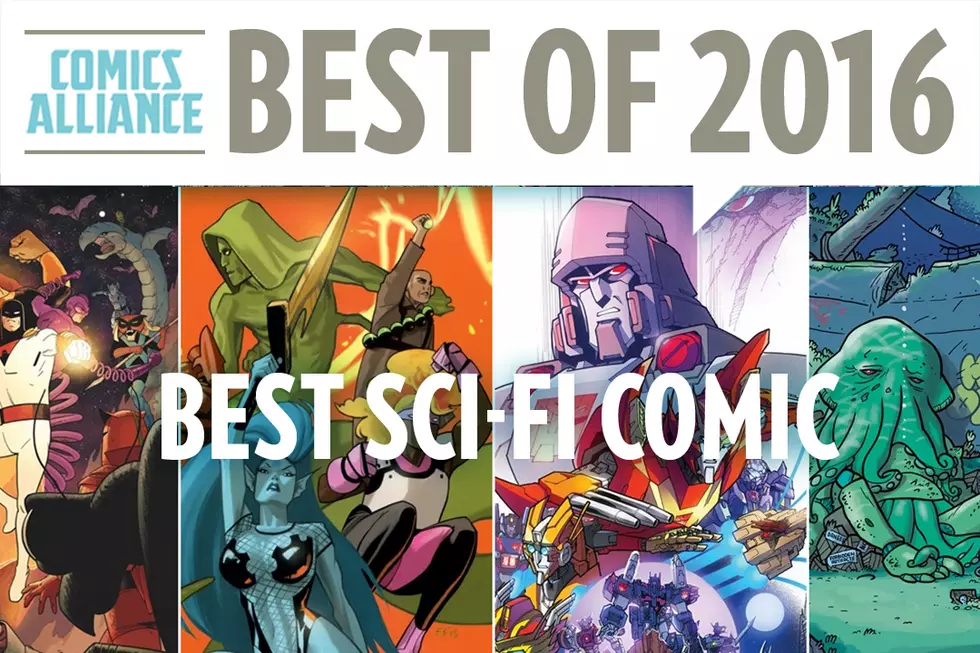![‘Saga': Brian K. Vaughan and Fiona Staples Bring a Stellar Sci-Fi Comic Into the World [Interview]](http://townsquare.media/site/622/files/2012/03/sagaposter.jpg?w=980&q=75)
‘Saga': Brian K. Vaughan and Fiona Staples Bring a Stellar Sci-Fi Comic Into the World [Interview]
 Brian K. Vaughan has come back to comics with a vengeance. With the conclusion of Y: The Last Man in 2008 and Ex Machina in 2010 -- and his departure from Lost after its fifth season in 2009, the highly successful creator dropped out of seemingly the entire public eye for a year. Vaughan return today with the first issue of Saga, ably abetted by the fantastic art of Fiona Staples (North 40, Mystery Society). While Vaughan's previous work has been very rooted in modern life and reality, from the politics of Ex Machina to the gender politics of Y, Saga charts new ground in an entirely invented science fiction universe that is beset by a war between the factions of magic and science, and home to one very special and unusual baby.
Brian K. Vaughan has come back to comics with a vengeance. With the conclusion of Y: The Last Man in 2008 and Ex Machina in 2010 -- and his departure from Lost after its fifth season in 2009, the highly successful creator dropped out of seemingly the entire public eye for a year. Vaughan return today with the first issue of Saga, ably abetted by the fantastic art of Fiona Staples (North 40, Mystery Society). While Vaughan's previous work has been very rooted in modern life and reality, from the politics of Ex Machina to the gender politics of Y, Saga charts new ground in an entirely invented science fiction universe that is beset by a war between the factions of magic and science, and home to one very special and unusual baby.
Saga #1 is 44 pages of story for $2.99 (print and digital), a significant value proposition in the current marketplace, and personally, I thought it was a corker. It's a very strong first issue with a unique identity, even (and especially) in the somewhat well-worn genre of epic fantasy comics, and ComicsAlliance talked with Vaughan and Staples about the first issue and the future of the series. But let's let Brian and Fiona take over.
ComicsAlliance: This is your first comic book work since the conclusion of Ex Machina, and instead of working with DC Comics/Vertigo again, you chose to go to Image, joining a number of major mainstream comic creators like Grant Morrison, Ed Brubaker and Jonathan Hickman. What's so attractive about publishing through Image?
Brian K. Vaughan: I love all the other companies I've worked with, but I think Image might be the only publisher left that can still offer a contract I would consider "fully creator-owned." Saga is a really important story to me, so I wanted a guarantee of no content restrictions or other creative interference, and I needed to maintain 100% control and ownership of all non-publishing rights with the artist, including the right to never have our comic turned into a movie or television show or whatever.[Image's] Eric Stephenson was the only publisher I spoke with who was thrilled to make that deal, and co-creator Fiona Staples and I didn't have to sign exclusives or agree to work on a bunch of corporate-owned titles to get it. Eric didn't even mind when we said we wanted our book to always cost $2.99, but to never be less than 22 pages long, a potentially risky equation in this marketplace. There's always a chance our gamble won't pay off, but so far, I couldn't be happier that Fiona and I decided to bet on ourselves by doing this series with Image.
CA: This book also charts new territory for you as a writer as your first major work in the space opera/fantasy vein. What has that transition been like? Are you creating the worlds organically as you write, or is there a big D&D-style sourcebook bible of the planets, the people, and their history somewhere on your hard drive?
BKV: Well, the universe of Saga is inspired by a weird "paracosm" I've been building in my head ever since I was a little kid, so I know a disturbing amount about its history, economy, etcetera. That said, the place only became real for me once Fiona started drawing it. Her characters and worlds are somehow both much more grounded and way more insane than anything I ever imagined. Anyway, Saga is definitely less research-intensive than a book like Y or Ex Machina, but the goal is always the same, which is to hopefully tell a cool story with beautiful visuals about some aspect of modern life I don't really understand.

CA: How did the storybook framing device come about? The narration lettered into the art is distinctly different from the standard comic book approach used throughout the rest of the book, or from typical caption narration. Why choose this approach?
BKV: Yeah, I don't think I ever wrote narration in any of my previous comics, so I guess I wanted to push myself to try something new with Saga. I've been reading a sickening amount of children's books recently, and I noticed how much my kids love whenever the text sort of playfully interacts with the images, rather than being cordoned off in a caption box or whatever. Felt like it might be a cool device to steal for Saga, particularly because of the unique relationship our narrator has to the events she's commenting on. Designer Steven Finch does amazing work with all of our dialogue, but that narration is the one thing Fiona letters herself, and I just love how organic it feels.
CA: The series so far seems to be based on a science vs. magic dichotomy, but both cultures are still similar enough to ours that Marko grew up with dogs and school buses. Are the cultures of Wreath and Landfall splintered off from a common stream, or is this giving too much away? How much of the "secret history" of the universe will we discover over the course of the series?
BKV: Like all warring factions, the people of Wreath and Landfall have much more in common than either side would like to admit. We'll definitely reveal more about this carefully crafted universe down the line, but I'm not a fan of world-building for its own sake. First and foremost, Saga is a story about people, not some impenetrable mythology.
CA: I love the robot people with television heads, and honestly, the sex scene in the first issue made me laugh out loud. Where'd the 1950s antiquated look of these guys come from and how do they fit into the societal picture of Wreath and Landfall? Are there any particular fantasy stories that influenced your work?
BKV: Thank you! I don't know, I've been fascinated with old televisions ever since I started writing for TV, so I'm sure that had something to do with it. I'm not terribly well versed in fantasy, so I'm mostly influenced by my own weird fetishes and observations about the real world. Though it's not exactly analogous, I suppose the Robot Kingdom's relationship to Landfall is almost as weird as the United States' current relationship with Saudi Arabia. Regardless, that sex scene is actually vitally important to our larger story, so I'm grateful that Fiona was deranged enough to show our bluebloods in their (mostly) anatomically correct splendor.

CA: Fiona, how'd you get started working with Brian? Were you introduced to him by a third party, or did he choose you on your past work?
Fiona Staples: It was our mutual friend Steve Niles who hooked us up! I worked with Steve last year on Mystery Society, and he was gracious enough to mention my name to Brian.
CA: How did your work on titles like North 40, Mystery Society and Hawksmoor prepare you for helping Brian create a whole new fantasy world from scratch?
FS: I'm not sure that it did! The comics I've done before have all taken place in the real world- screwed up, weird, or historical versions of it, but still obviously our planet. I guess working on those books helped in the sense that doing any kind of research, on whatever topic, will give a person a wider pool of ideas to draw from.
CA: Did the otherworldly nature of Saga require more design work than the average comic project?
FS: Definitely! There aren't very many items in Saga that I can just copy from real life, so everything from clothing to interiors to vehicles needs to be designed. But on the flip side, I don't need to worry about things looking "accurate." Rather, I try to design them to look "authentic," and look like they make sense in the context of that world.
CA: What are the major influences for your fantasy worldbuilding in Saga? Do they come from within or outside the fantasy genre?
FS: Most of my influences come from reality- just various places on Earth, particularly the ancient world. If I decide one planet's architecture is going to be loosely based on the Greek Islands, or one is going to be inspired by Mesopotamia, that's an easy way to keep the looks of those places consistent as our heroes trek around. And if I need to draw a convincing waterwheel or suit of armour or whatever, it's easier to modify something historical than to concoct those things out of thin air. I'd rather build the world from the ground up than poach things from other fantasy stories, but that said, I think a lot of the Final Fantasy games have really cool, well-realized designs! I'm also pretty inspired by Monkey Island, Sam & Max, Corto Maltese, illustrators like Maxfield Parrish, and tons of stupid things that I save on a Saga board on Pinterest. But hopefully you'd never know it by looking at the comic.
CA: What are your favorite fantasy stories of all time?
FS: I'll never love anything as much as the ones I read as a kid: The Princess and the Goblin by George MacDonald, The Dragon of the Lost Sea series by Laurence Yep, Brian Jacques' Redwall, and of course the Narnia books. I haven't found anything as an adult to equal the impact those books made on me!
Preview of Saga #1:





More From ComicsAlliance


![Comics’ Sexiest Female Characters (From A Queer Perspective) [Love & Sex Week]](http://townsquare.media/site/622/files/2017/02/hg_featured.jpg?w=980&q=75)






